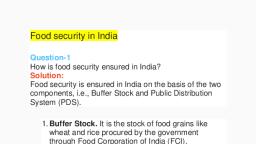Question 3 :
Buffer stocks and public distribution system are the two components of ____________.
Question 4 :
The stock of foodgrains - mainly wheat and rice - procured by the government for distribution under PDS is called _____.
Question 5 :
Farmers are paid a pre-announced price by the government for their crops. It is called _______.
Question 6 :
Under the Integrated Child Development Scheme, steps have been taken to eradicate ___________ among children.
Question 7 :
The price that is announced by the government before the sowing season is called ________.
Question 14 :
The significant growth and expansion in agriculture that took place in India during the 1970s is known as _________.
Question 16 :
Name the cooperative body that provides milk, vegetable and pulses at controlled rate decided by government of Delhi.
Question 18 :
The accepted average calorie requirement in India is _____ calories per person per day in rural areas and _____ calories per person per day in urban areas.
Question 19 :
Even though India is self-sufficient in food production, a large number of people still suffer from hunger because of ___________.
Question 20 :
Consider the statements and select the correct code given below: 1. Global Hunger Index is released annually by the US-based food research institute IFPRI. <br/>2. IFPRI is funded by governments of the world, private businesses, foundations and the World Bank other than the UNO.
Question 21 :
Which coloured ration card is given to the families below poverty line?
Question 22 :
In mid $1840s$, many people died of starvation when potato crop was destroyed due to a particular disease. Name the country associated with the above incident.
Question 24 :
With reference to 'Initiative for Nutritional Security trough Intensive Millets Promotion', which of the following statements is/ are correct?<br>1. This initiative aims to demonstrate the improved production and post-harvest technologies, and to demonstrate value addition techniques, in a integrated manner, with cluster approach.<br>2. Poor, small, marginal and tribal farmers have larger strake in this scheme.<br>3. An important objective of the scheme is to encourage farmers of commercial crops to shift to millet cultivation by offering them free kits of critical inputs of nutrients and micro irrigation equipment.<br>Select the correct answer using the code given below.
Question 27 :
The system which ensures the provision of food at all times to everyone in the country is called _________.
Question 29 :
Two crops that increased India's agriculture production in the era of Green Revolution were _____.
Question 30 :
The stock of foodgrains procured by the government through Food Corporation of India is called _______.
Question 32 :
Out of the following, which are the four components of food security?<br>(i) Food availability<br>(ii) Food market<br>(iii) Food accessbility<br>(iv) Food utilization<br>(v) Food credit.
Question 34 :
FCI purchases and stores foodgrains and distributes it in deficit areas at a price less than the market price known as
Question 38 :
Cooperative societies set up shops to sell low priced goods to _____.
Question 40 :
Which institution was set up by the Academy of Development Science to facilitate a network of NGOs?
Question 41 :
The rationing system was revived in the wake of an acute food shortage during the 1960s, prior to the _____.
Question 42 :
_____ means food production within the country, food imports and the previous year's stock stored in government granaries.
Question 43 :
Which of the following step is taken in agriculture to make India self-sufficient in food grains?
Question 45 :
Amul, a success story of cooperatives in milk and milk products, is from ____.
Question 48 :
Buffer stock is the stock of foodgrains procured by the government through _____.
Question 49 :
Public Distribution System (PDS) is the most important step taken by the Government of India towards ____________________.
Question 51 :
The unsustainable levels of government deficits in the late $80$'s can be attributed to:
Question 52 :
Mother Dairy is making strides in provision of milk and vegetables to the consumers at controlled rates decided by _____.
Question 53 :
Ration shops also known as _____ keep stocks of food grains, sugar, and kerosene oil for cooking.
Question 54 :
The rising minimum support prices have increased the cost of _____.
Question 61 :
According to the National Sample Survey Organization estimates, in 2011-12 _______ percent people in India were poor.
Question 63 :
The major benefits of the "Green Revolution" were experienced mainly in _____.
Question 66 :
Which organisation has facilitated a network of NGOs for setting up grains banks in Maharashtra?
Question 68 :
Assertion: The Government of India buys wheat and rice from farmers at fair price.
Reason: Public sector contributes to the economic development.
Question 70 :
The introduction of rationing in India dates back to the ______.





























